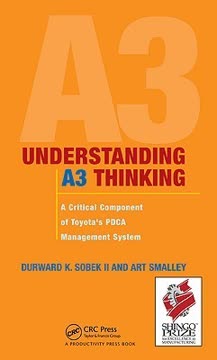Key Takeaways
1. A3 Thinking: The Heart of Toyota's Problem-Solving Approach
Toyota uses a simple, semistructured one-page document as its primary tool to implement PDCA management across all departments and all levels of the organization.
A3 reports are powerful tools for problem-solving, proposal writing, and project status reviews. They are called A3 because they fit on a single A3-sized sheet of paper (roughly 11x17 inches). The A3 report is not just a documentation format, but a mechanism to foster deep learning, engaging collaboration, and thoroughness in problem-solving.
The A3 process encourages:
- Logical thinking
- Objectivity
- Focus on both results and process
- Synthesis and distillation of information
- Organizational alignment
- Coherence within and consistency across departments
- Systems thinking
A3 reports make the author's thought processes visible, enabling better coaching and mentorship. They serve as boundary objects between parties, helping to communicate quickly and effectively across departments and hierarchies.
2. PDCA Cycle: The Foundation of Continuous Improvement
The overall flow of the report format embodies the Plan-Do-Check-Act cycle of management.
PDCA is the backbone of A3 thinking. The Plan-Do-Check-Act (PDCA) cycle, also known as the Deming Cycle, is a fundamental concept in continuous improvement and quality management. It forms the basis of Toyota's problem-solving approach and is reflected in the structure of A3 reports.
PDCA cycle in A3 reports:
- Plan: Define the problem, analyze the current situation, and develop potential solutions
- Do: Implement the chosen solution on a small scale
- Check: Evaluate the results of the implementation
- Act: Standardize the solution if successful, or start the cycle again if not
The A3 report structure ensures that each step of the PDCA cycle is thoroughly addressed, promoting a systematic and scientific approach to problem-solving and continuous improvement.
3. Three Types of A3 Reports: Problem-Solving, Proposal, and Status Review
There is no single right way to write A3 reports. Each is unique in content, and even the framing mechanism changes in many cases.
A3 reports come in three main types, each serving a different purpose but all following the basic PDCA structure:
-
Problem-Solving A3:
- Used for day-to-day operational issues
- Focuses on identifying and resolving root causes
- Typically written after the Plan, Do, and Check steps
-
Proposal A3:
- Used for suggesting new policies or significant changes
- Written during the Plan step, before implementation
- Involves more extensive analysis and comparison of alternatives
-
Status Review A3:
- Used for reporting on project progress or results
- Focuses on the Check and Act phases of PDCA
- Compares actual results to predicted outcomes
While these types provide a starting point, A3 reports are flexible and can be adapted to suit specific situations and organizational needs.
4. The Seven Elements of Effective A3 Thinking
A3 thinking attempts to reconcile those multiple viewpoints, in part because a view of the situation that includes multiple perspectives tends to be more objective than any single viewpoint.
A3 thinking encompasses seven key elements that contribute to effective problem-solving and decision-making:
- Logical thinking process: Emphasizes rational, step-by-step analysis
- Objectivity: Focuses on facts and data rather than opinions or assumptions
- Results and process: Balances achieving outcomes with following proper procedures
- Synthesis, distillation, and visualization: Condenses complex information into clear, visual formats
- Alignment: Ensures agreement among stakeholders on the problem and solution
- Coherency within and consistency across: Maintains a logical flow within the report and across different reports
- Systems viewpoint: Considers the broader impact of decisions on the entire organization
These elements work together to create a comprehensive and effective approach to problem-solving, encouraging thorough analysis, clear communication, and organizational alignment.
5. Visualizing the Current Condition: A Critical Step in Problem-Solving
To actually generate a bill, the patient's medical file (or chart) must be coded, that is, assigned a numerical code for each service rendered for the purposes of insurance billing.
Depicting the current state visually is a crucial step in the A3 process. It forces the author to observe the situation firsthand, gather detailed data, and present a clear picture of the problem or opportunity.
Benefits of visualizing the current condition:
- Encourages direct observation (gemba)
- Reveals hidden issues and relationships
- Facilitates shared understanding among stakeholders
- Stimulates deeper analysis and questioning
- Provides a baseline for measuring improvement
Effective visualization techniques:
- Process flow diagrams
- Value stream maps
- Pareto charts
- Fishbone diagrams
- Spaghetti diagrams
By creating a visual representation of the current state, A3 authors can more easily identify areas for improvement and communicate complex situations to others.
6. Root Cause Analysis: Getting to the Heart of the Problem
After sifting through the various causes, it became apparent that the main cause of this confusion was that the system lacked clear signals for indicating when ED physicians had done their dictations and when transcriptions were ready for download.
Identifying the true root cause is essential for effective problem-solving. The A3 process emphasizes thorough root cause analysis to ensure that solutions address the underlying issues rather than just symptoms.
Common root cause analysis techniques:
- 5 Whys: Asking "why" repeatedly to dig deeper into the problem
- Fishbone diagram: Visualizing potential causes in categories
- Pareto analysis: Identifying the vital few causes among the trivial many
Key principles of root cause analysis:
- Focus on systemic issues rather than blaming individuals
- Use data and direct observation to support findings
- Consider multiple perspectives and potential causes
- Validate root causes through testing or further investigation
By conducting a thorough root cause analysis, A3 authors can develop more effective and sustainable solutions to problems.
7. Implementing Countermeasures and Checking Results
As predicted, both cost and time dimensions have improved considerably using the new card system, although time has not improved as much as expected.
Implementing solutions and verifying results are critical steps in the A3 process. Countermeasures should directly address the identified root causes, and their effectiveness must be confirmed through data collection and analysis.
Key aspects of implementation and verification:
- Develop specific, actionable countermeasures
- Create a clear implementation plan with responsibilities and timelines
- Establish metrics for measuring success
- Collect data to verify the impact of countermeasures
- Compare actual results to predicted outcomes
- Analyze discrepancies between expected and actual results
If the implemented countermeasures do not achieve the desired results, the A3 process encourages returning to earlier steps to reassess the problem and develop new solutions. This iterative approach ensures continuous improvement and learning.
8. The Power of Hand-Drawn A3 Reports
We strongly recommend creating A3s by hand initially, especially when it comes to depicting the current condition.
Hand-drawn A3 reports offer unique benefits in the problem-solving process, particularly for beginners. While computer-generated reports have their place, starting with hand-drawn reports can enhance learning and creativity.
Advantages of hand-drawn A3 reports:
- Encourages deeper thinking about the problem
- Allows for quick sketches and revisions
- Facilitates on-site data capture and rapid feedback
- Promotes creativity and flexibility in visualization
- Reduces focus on formatting and software manipulation
Tips for creating effective hand-drawn A3 reports:
- Use simple, clear sketches to represent processes and data
- Include quantitative information where possible
- Organize information logically on the page
- Use consistent symbols and notations
- Practice neat handwriting for readability
As authors become more experienced with A3 thinking, they can transition to computer-generated reports while maintaining the benefits of the hand-drawn approach.
9. Mentorship and Approval: Key Components of the A3 Process
At Toyota, every A3 report is written and submitted to someone, often a manager or supervisor, who critically evaluates the report, the problem-solving process used, and the results.
Mentorship and approval processes are crucial for developing problem-solving skills and ensuring organizational alignment. The A3 report serves as a tool for dialogue between the author and their mentor or approver.
Key aspects of mentorship and approval:
- Regular check-ins during the A3 development process
- Critical evaluation of the problem-solving approach
- Guidance on improving analysis and communication
- Ensuring alignment with organizational goals and priorities
- Promoting cross-functional collaboration and consensus
The approval process typically involves:
- Review by the author's immediate supervisor
- Additional reviews by higher-level managers for more significant issues
- Consensus-building among affected stakeholders
- Formal approval before implementation of proposed solutions
By integrating mentorship and approval into the A3 process, organizations can develop their employees' problem-solving skills while ensuring that improvement efforts are aligned with overall company objectives.
10. A3 Reports as a Tool for Organizational Learning and Alignment
A3 reports are excellent tools for persuading people in a factual, rational manner.
A3 reports facilitate organizational learning and alignment by providing a structured approach to problem-solving and decision-making. They serve as a common language for improvement across departments and hierarchies.
Benefits of A3 reports for organizational learning:
- Capture and document problem-solving processes
- Facilitate knowledge sharing across the organization
- Provide a basis for comparing similar problems and solutions
- Encourage systematic thinking and analysis
- Promote a culture of continuous improvement
A3 reports also support organizational alignment by:
- Ensuring that improvement efforts align with company goals
- Facilitating cross-functional collaboration
- Providing a clear, concise format for communicating complex issues
- Encouraging consensus-building and stakeholder involvement
- Standardizing problem-solving approaches across the organization
By consistently using A3 reports, organizations can build a shared understanding of problems and solutions, leading to more effective and aligned improvement efforts.
Last updated:
FAQ
What is "Understanding A3 Thinking" by Durward K. Sobek II about?
- Comprehensive guide to A3 thinking: The book explains the A3 report as a core tool in Toyota’s PDCA (Plan-Do-Check-Act) management system, emphasizing its role in structured problem-solving and continuous improvement.
- Focus on thinking, not just tools: It stresses that A3 is more than a reporting format; it’s a disciplined way of thinking and communicating that underpins Toyota’s success.
- Practical application: The book provides step-by-step guidance, examples, and exercises for writing and reviewing A3 reports in various organizational contexts.
- Transferable methodology: While rooted in Toyota’s practices, the concepts are presented as broadly applicable to any organization seeking to improve problem-solving and management effectiveness.
Why should I read "Understanding A3 Thinking" by Durward K. Sobek II?
- Learn Toyota’s secret sauce: The book demystifies the thinking and processes behind Toyota’s sustained excellence, which many companies try but fail to replicate.
- Develop problem-solving skills: It offers actionable methods to improve both individual and organizational problem-solving capabilities.
- Enhance communication and alignment: Readers gain tools to foster clearer, more objective, and more collaborative communication within teams.
- Applicable across industries: The A3 approach is shown to work in manufacturing, healthcare, services, and more, making it valuable for a wide audience.
What are the key takeaways from "Understanding A3 Thinking"?
- A3 is a thinking process: The value lies in the disciplined, logical, and collaborative approach to problem-solving, not just the report format.
- PDCA is foundational: The Plan-Do-Check-Act cycle is the backbone of continuous improvement and is deeply embedded in Toyota’s culture.
- Seven elements of A3 thinking: Logical thinking, objectivity, focus on results and process, synthesis and visualization, alignment, coherence, and a systems viewpoint are essential.
- Mentoring and learning: The A3 process is as much about developing people as it is about solving problems, with mentoring and review being central.
How does "Understanding A3 Thinking" define the A3 report and its purpose?
- One-page structured report: An A3 report is a concise, visual, and structured document (typically one side of an 11x17” sheet) that summarizes a problem, analysis, countermeasures, and action plans.
- Tool for PDCA management: It operationalizes the PDCA cycle, making thinking and decision-making visible and reviewable.
- Facilitates alignment and learning: The A3 report is a focal point for discussion, feedback, and consensus-building across functions and levels.
- Not just documentation: The process of creating and discussing the A3 is more important than the document itself.
What are the seven elements of A3 thinking described by Durward K. Sobek II?
- Logical thinking process: Emphasizes disciplined, step-by-step reasoning and clear cause-effect relationships.
- Objectivity: Encourages fact-based analysis, minimizing bias and subjective opinions.
- Results and process: Stresses the importance of achieving results through robust, repeatable processes.
- Synthesis, distillation, and visualization: Requires condensing complex information into clear, visual, and actionable insights.
- Alignment: Focuses on building consensus and shared understanding across stakeholders.
- Coherency within and consistency across: Ensures logical flow within the report and consistency with organizational goals and other reports.
- Systems viewpoint: Promotes understanding the broader context and avoiding sub-optimization.
How does the PDCA (Plan-Do-Check-Act) cycle underpin A3 thinking in the book?
- Framework for improvement: PDCA provides a structured approach to problem-solving and continuous learning.
- Emphasis on planning: Toyota invests heavily in the Plan phase to deeply understand problems before acting.
- Check and Act are critical: The book highlights the importance of verifying results and institutionalizing successful changes.
- Iterative learning: PDCA is a repeating cycle, fostering ongoing improvement rather than one-off fixes.
What are the main types of A3 reports explained in "Understanding A3 Thinking"?
- Problem-solving A3: Used to analyze and resolve specific issues, following the PDCA cycle closely.
- Proposal A3: Developed during the planning phase to recommend significant changes, policies, or investments, often before implementation.
- Status (or project review) A3: Summarizes progress, results, and next steps after implementation, focusing on the Check and Act phases.
- Flexible templates: While each type has a typical structure, the book emphasizes adapting the format to fit the situation and audience.
What is the practical process for problem-solving using A3 thinking, according to the book?
- Grasp the current situation: Go to the actual place (genba), observe, and collect data to understand the problem context.
- Identify root causes: Use techniques like the 5 Whys and fishbone diagrams to dig beyond symptoms.
- Devise and visualize countermeasures: Brainstorm and select actions that address root causes, and depict the future state.
- Create and execute implementation and follow-up plans: Assign responsibilities, set timelines, and plan how to check effectiveness.
- Engage stakeholders: Discuss with affected parties, obtain approval, and ensure alignment throughout the process.
How does "Understanding A3 Thinking" advise on writing effective A3 reports?
- Be concise and visual: Fit all key information on one page, using diagrams, charts, and tables where possible.
- Use clear structure and flow: Organize sections logically (background, current condition, analysis, countermeasures, etc.).
- Write for the audience: Tailor content and language to the needs and knowledge of the intended readers.
- Prioritize clarity and brevity: Avoid jargon, repetition, and unnecessary detail; highlight key points for quick understanding.
What role do mentoring and review play in the A3 process, as described by Durward K. Sobek II?
- Mentoring opportunity: Managers use A3 reviews to coach and develop problem-solving skills in their teams.
- Socratic questioning: Reviews often involve probing questions to test the author’s understanding and reasoning.
- Ensures rigor and alignment: The review process checks for thoroughness, objectivity, and consensus among stakeholders.
- Promotes organizational learning: Sharing and critiquing A3s helps disseminate best practices and lessons learned.
What are common pitfalls or misconceptions about A3 thinking and how does the book address them?
- Form over substance: Mistaking the A3 report as just a documentation tool, rather than a thinking and learning process.
- Template rigidity: Over-standardizing the format at the expense of flexibility and context-appropriate communication.
- Skipping steps: Neglecting the Plan or Check phases, or failing to engage stakeholders and mentors.
- Superficial analysis: Stopping at symptoms rather than digging for root causes, or implementing solutions without verification.
What are some of the best quotes from "Understanding A3 Thinking" and what do they mean?
- “A3 is more of a way of thinking than a report-writing methodology.” – Emphasizes that the mindset and process are more important than the document itself.
- “The A3 provides a disciplined way of reporting on problems that encourages a disciplined way of solving problems.” – Highlights the link between structured communication and effective problem resolution.
- “The process of creating and discussing the A3 is more important than the document itself.” – Reminds readers that collaboration, feedback, and learning are central to the A3 approach.
- “Do not become slave to a format, but use the format as a standard for starting your A3 reports.” – Encourages flexibility and adaptation rather than rigid adherence to templates.
- “Improvement efforts in companies become ineffective when the emphasis becomes adhering to a standard tool and enforcing a certain way of doing things.” – Warns against prioritizing tools over genuine improvement and learning.
Review Summary
Understanding A3 Thinking receives mostly positive reviews, with readers praising its insights into Toyota's problem-solving approach. Many find it valuable for Lean practitioners and project managers. The book is lauded for its explanation of A3 reports, PDCA cycle, and data-driven decision-making. Some readers note its focus on manufacturing and suggest prior knowledge of Lean concepts is helpful. A few criticisms mention repetition and dryness, but overall, readers appreciate the book's practical advice and its emphasis on systematic problem-solving and organizational alignment.
Similar Books
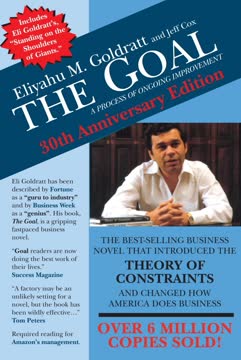

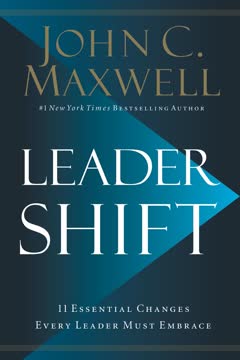
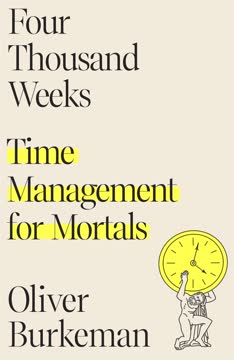
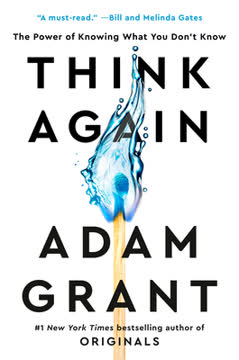
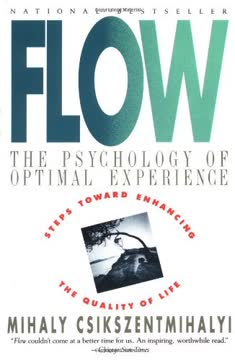
Download PDF
Download EPUB
.epub digital book format is ideal for reading ebooks on phones, tablets, and e-readers.
